Organic cannabis has become somewhat of a specialty product in the cannabis industry. As more and more marijuana grown commercially continues with pesticide use and non-organic fertilizers, organically grown cannabis is an increasingly appealing option for many.
Additionally, the 2014 Farm Bill officially made it so industrial hemp could be grown legally within the United States. This means that virtually anyone can now legally grow and process hemp once they obtain the right permit.
With this being the case, the US cannabis industry now allows for the production of CBD oil or other herbal extracts from industrial hemp, which could be sold legally as long as they do not contain any THC (less than 0.3%).
However, because of the lack of regulation in this arena, it’s now more important than ever for organic growers to differentiate themselves from the many cannabis growers that use toxic chemicals.
But more importantly, is organic marijuana worth the investment?
Yes, especially now that many states have legalized recreational cannabis, consumption is at an all-time high. And with this increase stemming from legal weed, we can expect more consumption – and more health and environmental concerns – once consuming and growing weed becomes legal at the federal level.
Whether you’re smoking weed or considering growing organically, this post aims to cover the ins and outs of organically grown cannabis plants. Keep reading for insight into organic marijuana!

Organic Cannabis Cultivation Benefits
Considering purchasing or growing organic cannabis? Then you’re in luck! Whether you’re consuming or growing medicinal or recreational marijuana, organic cannabis minimizes health risks while offering assortment o benefits.
Here’s a list of the top reasons to grow cannabis organically:
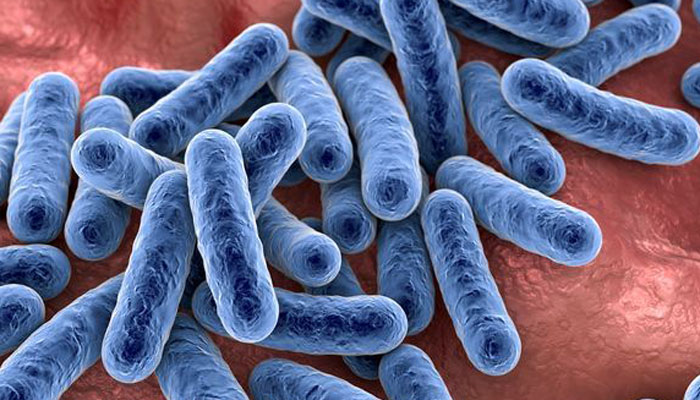
1. Organic Cannabis Cultivation Offers a Richer Microbiome
Organic marijuana soil mixes have a better microbiome. For those new to growing organic cannabis, the soil food web is an essential part of organic and non-organic cannabis alike. However, the beneficial microbes found in an organic soil food web is second to none.
Your organic soil food web is rich in beneficial bacteria that enables Mother Nature – and organic marijuana growers – to produce the healthiest plants possible. Unlike many of the fertilizers used to increase soil fertility, this microbial life comes from organic sources. We’ll cover some of these sources later in this post.
These organic cannabis soil mixes offer impressive complexity. They contain bacteria, fungi, nematode worms, and other microscopic organics that contribute to healthy growth for organic marijuana plants. It’s impossible to find this level of complexity in a store-bought fertilizer.
Your soil fertility increases tremendously as it maintains nitrogen and retains water. Organic marijuana also benefits from the additional stimulation and a lower chance of developing root diseases.

2. Organic Cannabis is Safer for Human Consumption
The federal government might be quicker to legalize recreational marijuana if more farmers began growing organically. But that’s neither here nor there.
Consumers are becoming more knowledgeable about what’s happening in the cannabis industry, among others. And this is leading to them making better choices.
Of, course, this includes choosing to grow organic cannabis small-scale at home. But the large-scale outdoor cultivation operations are even beginning to work on their environmental impact.
So, why aren’t more farmers working with Mother Nature to produce organic cannabis in accordance with USDA organic standards? Well, for starters, the USDA doesn’t have standards for the cannabis sector – at least not yet!
With this in mind, unsafe cultivation practices tend to be more affordable. And while higher quality comes with using worm castings and beneficial insects as opposed to non-organic growing medium and chemical-ridden pest control options, cannabis grown outdoors using these unsafe growing methods is cheaper to produce at scale.
Some cultivators are willing to invest in natural materials for their cannabis farms. However, the risk of smaller yields – and profits – deters many from farming organic marijuana.
The main difference between organic soil-grown cannabis that uses natural ingredients is that the cultivator doesn’t use chemical fertilizers and pesticides. Even though this helps cannabis plant growth and flowering, natural nutrients like neem oil and bone meal are available – and safer.
Organic cannabis nutrients are actually quite inexpensive. Sometimes, they’re free as cultivators can make them themselves through composting.
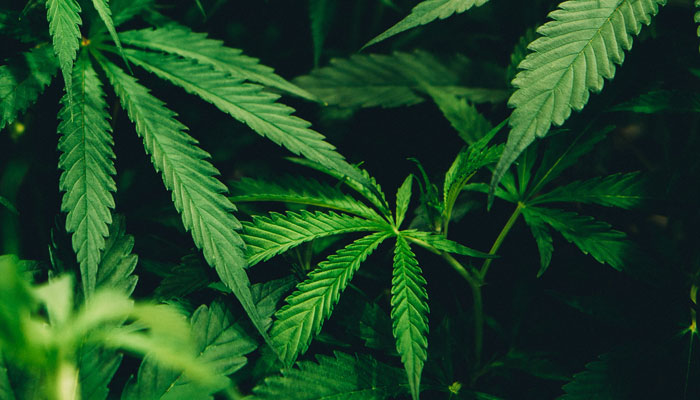
3. Organic Marijuana is a Premium Product
Organic cannabis plants are grown with organic matter and other high-quality materials. The farmers care more about their grows than black market growers, and the higher cost ensures consumers and retailers are getting exactly what they expect – quality cannabis products.
Think about Whole Foods. Like the premium produce and products at this grocery store, organic cannabis bypasses the icky stuff that’s grown commercially. Instead of growing large quantities of cannabis with fertilizers that contain heavy metals that’ll seep into the buds, these smaller growers use organic matter and a cover crop in their cultivation process.
Cannabis nutrient systems can be simple; but what’s more is how they offer cannabis plants what they need to survive without harming the environment or the people that consume it.
Although, some argue that organic cannabis is not as potent as non-organic, this myth stems from a lack of evidence and research. However, there are different compounds found in nature that contribute to a high. Not to mention, some of the cannabis grown commercially uses foliar spray or other additive chemicals that might make a consumer feel higher.
One thing is for certain: the USDA doesn’t certify large-scale growers with pesticides and fertilizers. Thus, they cannot be so confident in their product when they use these materials.
Rather, organic cannabis farms are less likely to have contaminants due to the fact that they keep the soil or environment as natural as possible during cultivation. Additionally, growers are able to guarantee their customers a safer product when they stick with growing methods that don’t include harmful chemicals and synthetic materials.
So why isn’t every cannabis cultivator using bones, organic matter fertilizer and weed spraying to their plants with natural stuff instead of harmful chemicals? Perhaps it’s for the same reason that illicit growers use dangerous fertilizers and chemicals: it’s easier to grow in large quantities.
Not only is organic marijuana expensive but it’s slowly becoming a luxury product. Growing indoors with organic nutrient systems offers trace elements. Even though these aren’t essential, they’re not offered in common fertilizers. Sodium, cobalt, nickel, and chlorine are all essential micronutrients that play a very small role in cannabis plant growth. But this small difference with these, along with other essential macronutrients, is significant and contributes to the quality of organic cannabis plants.
Simply put, you will not get the same premium product with commercial fertilizers that you’ll find using organic cannabis nutrient mixes.

4. Smaller Yields Driving Organic Cannabis Grows
Commercial growers are concerned over organic cannabis cultivation because they believe a smaller yield isn’t good for business. However, when the conditions are right, massive yields are possible – not to mention, the product is even better and demands a premium, too.
But the main issue is with large commercial growers and how they use synthetics in their cultivation process. Fertilizers such as MiracleGro can actually attract pests that eat nutrients, direct chemical absorption, and suffocate roots.
In contrast, organic matter holds onto water and nutrients for plant uptake during all stages of life: seedling to flowering.
Organic cannabis growers don’t need to use fertilizers; instead, they utilize sustainable farm management and great living soil. This means everything in their garden is produced and sourced locally and regionally with eco-friendly practices leading the way.
One thing about organic farming: it’s a fail-proof way to guarantee your product is free of contaminants because you keep environmental conditions as natural as possible during cultivation.
Another thing about organic farming is that your grow becomes a living ecosystem, too. This means it’s less likely for you to have pest problems because the soil has everything it needs already inside of it to grow things. Pest elimination can prevent any damage or harm done by harmful insects that may contaminate your marijuana plants along the way.
However, this means you’ll need to develop a proper micro-environment. Without this dedication, non-organically grown marijuana might be a better product. Fortunately, these days, it’s easier to grow marijuana organically than in the past. With organic fertilizers readily available for commercial cannabis grows now more common than ever, it’s not so challenging to commit to these excellent growing practices.
Cultivators also have a better understanding about these grow recommendations. For instance, they know which natural fertilizers should be used in the vegetative and flowering stages of their marijuana plants. This is something commercial cultivators need to do if they want to grow organic cannabis.
Organic weed will cost you more than other forms of the herb. However, it’s worth it if you would rather avoid consuming potentially problematic chemicals.
The only way you can be sure your weed is free of these substances is by growing it yourself or finding a trustworthy retailer that carries organic cannabis.
It’s not easy to find the right distributor for this type of product. But if you do your research and have a look around, reputable growers with high-quality organic products available exist.

5. Organically Grown Cannabis is More Flavorful & Aromatic
Cannabis flowers have a distinctive flavor and scent. The terpene profile of the plant is complex, yet these small molecules contribute to the overall character of its taste and fragrance.
Terpenes are hydrocarbons produced by the same glands resin that hold THC concentrations in marijuana plants. These compounds give cannabis its aromatic diversity. Different types of terpenes are also categorized by their effects on the human body, including flavor and smell.
Organically grown marijuana has much more flavor to it than non-organically grown cannabis. This is because cultivators use sustainable practices at every stage of the growing process to maintain natural living conditions for their plants without using any pesticides during the vegetative and flowering stages.
These powerful smells are unique because each strain has their own terpene profile that differentiates them from other strains. These aromas are what some consumers use to determine which strain they prefer. But some terpenoids offer impressive benefits.
Here’s a list of terpenes prevalent in cannabis:
Limonene
Limonene is a terpene that gives cannabis strains a wonderful citrus flavor. It’s also known to reduce stress levels and uplift your mood. Limonene can also help improve digestion, which makes it a great remedy for gastrointestinal issues.
Pinene
Marijuana strains with high amounts of pinene have a potent pine aroma. Pinene has tons of health benefits including antibacterial, anti-fungal and anti-proliferative properties.
Humulene
Cannabis strains with high amounts of humulene have a strong woody scent. Humulene is also good for your digestive system with its appetite suppression abilities. It can also relieve symptoms of asthma and arthritis.
Myrcene
Myrcene is a unique terpene with a musky scent. It can also help combat anxiety and depression, reduce inflammation and even help cancer patients undergoing chemotherapy.
Other terpenes exist, and these compounds make each strain unique. Some cultivators like growing cannabis that offers a skunky or citrusy scent. However, others like the diesel and pine-like aromas even better.
Regardless, the aromatic compounds in organic marijuana can become more highly accented with the right growing conditions. And this is important to consider as a grower.

6. Organically Grown Marijuana Doesn’t Damage the Planet
Organically grown weed can help reduce the environmental impact of cannabis on our world. It’s true that growing cannabis is not as environmentally harmful as some other agricultural crops such as soy or corn. But it does still affect our planet in a similar fashion to most plants if it doesn’t use natural sunlight.
Marijuana cultivation has been linked to deforestation, soil erosion, energy consumption, and water waste. Some who grow cannabis might use chemical fertilizers, which results in high nitrogen levels that can drain into local waterways.
For example, in Oregon, some streams have even become devoid of aquatic life because of over-fertilization from cannabis cultivators. Chemical pesticide runoff is a serious problem. And don’t forget the energy aspect of growing this plant indoors!
The organic movement has all but eliminated these damaging practices. But between farmers using organic compost tea and other alternatives to chemical-ridden pesticides, these practices are an improvement.
Organic farming uses techniques to protect the environment, soil health, and wildlife habitats. These methods are all important ways to reduce our carbon footprint on planet Earth while producing an end product that’s better for consumers and the environment.
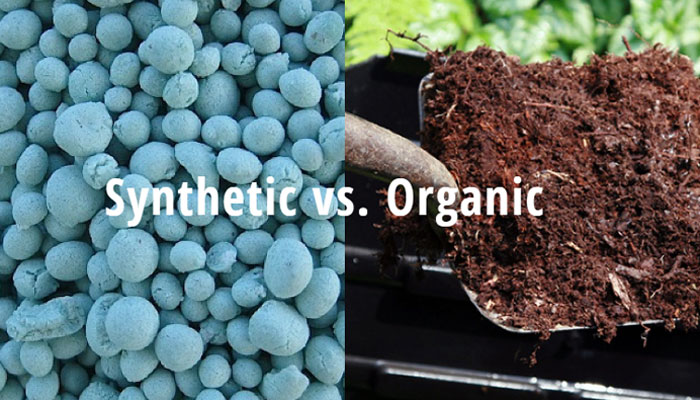
Synthetic vs Organic Fertilizers for Cannabis
Some modern cannabis growers use monoculture production methods for their commercial cannabis production.
Monoculture is the practice of growing massive amounts of a single species/strain in an area. Growth-optimizing techniques are implemented to make cannabis grow as fast as possible with little regard for health or the environment.
Monoculture typically involves manufactured nutrients that contain precise NPK values and a relatively narrow pH range. This is done to keep things efficient enough for lightning-fast growth.
But is this really worth the impact on the environment? Not likely.
Growing organic marijuana involves using soil microbiology to nourish the plants. Similar to how we observe natural organic ecosystems, growers feed cannabis plant roots using natural proportions rather than trying to get the plants to grow obscenely fast and fat.
This is especially challenging for first-time growers. However, growing cannabis organically means you’ll have a better product that doesn’t contain the same harmful chemicals.
If you’re considering using bottled fertilizers, remember; they’re not always synthetic. But unlike the stuff you make yourself with compost tea and other natural byproducts, these organic fertilizers are usually heavily diluted. Also, keep in mind, having the totality of your organic cannabis nutrients in a single stabilized solution is nearly impossible because of the chemistry and plant physiology limitations.

Organic Nutrients for Cannabis Plants
You may grow your own organic cannabis by developing your own fertilizer. The following are some of the key organic cannabis macronutrients required to promote plant growth:

Nitrogen (N)
Nitrogen is a plant macronutrient that’s important to cannabis growth because it promotes the health of your flowers and foliage. Nitrogen is also helpful in producing those lush green leaves you want from your cannabis.
Nitrogen deficiencies can also show up in older or lower leaves first. You’ll see yellowing and browning of the leaves, mainly between the veins because it affects how well photosynthesis occurs.
Just like people, cannabis loves variety. Marijuana plants thrive on different types of nitrogen sources depending on their life cycle stage. One type isn’t good for all growth periods, so it’s important to keep an eye on the vegetative and flowering stages.

Phosphorus (P)
Phosphorus is closely associated with nitrogen because it helps your cannabis grow strong roots that are crucial for being able to uptake nutrients. Marijuana plants derive phosphorus from natural sources in soil or water. But they also need phosphorus in the form of a nutrient to produce healthy root systems.
Phosphorus deficiencies show up when you work on your cannabis plant too much and cause stress. You can end up with strange symptoms like twisty leaves that thicken and curl in, and stunted growth in flowering plants (and sometimes in vegetative).
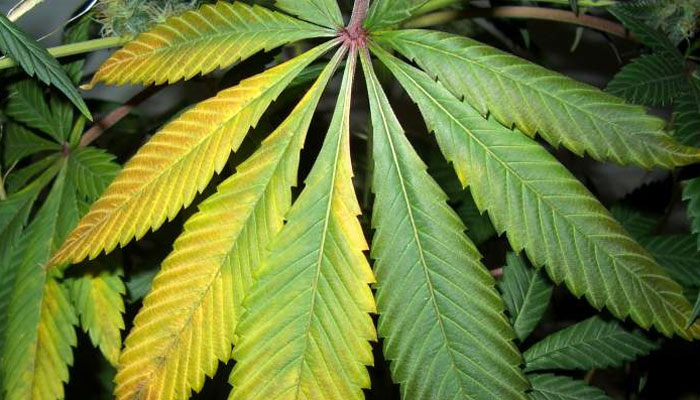
Potassium (K)
Potassium helps your cannabis plant grow by providing strength and disease resistance. These benefits also translate into bigger yields and more abundant harvests.
When you’re experiencing a potassium deficiency, you’ll notice lower growth rates in flowering plants, yellowing leaves with distinct purple veins, and less resin production on the buds themselves.
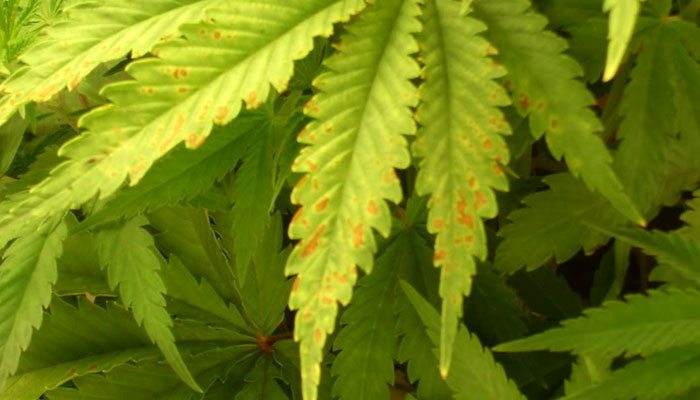
Calcium (Ca)
Calcium helps marijuana plants grow strong leaves and stems by promoting cell division and growth. These benefits result in better nutrient uptake and stronger plants. Potassium deficiencies will show up through yellowing leaves, often between the veins: these thickened leaves may also twist and curl inward.

Magnesium (Mg)
When your marijuana plant doesn’t have a magnesium deficiency, you can expect it to be more resistant to heat and cold. You’ll also see stronger stems and sturdier leaves that produce those nice thick buds your smoking buddies love so much.
Your cannabis plant needs magnesium from natural nutrients in soil or water as well as from fertilizers. If your plants are deficient, the first sign is yellowing leaves that show up closer to the leaves’ veins.

Chlorine (Cl)
This chemical element is yet another essential nutrient for marijuana plants because it regulates water uptake. This is crucial during all stages of plant growth, but especially key during the vegetative stage when your plants are using a lot of water.
When you don’t have chlorine in your soil, your marijuana plants are definitely going to suffer because it affects how well they can take up nutrients.
If you’re seeing these signs of a chlorine deficiency, then do yourself a favor and find some fertilizer that contains this important element.
These are just the major macronutrients for marijuana plants. There are also micronutrients like boron, cobalt, copper, molybdenum, and zinc that your plants need to thrive. They’re important too because they work together with the macronutrients so that your plants can do what they’re supposed to do: produce big, healthy, organic buds!
Natural Sources for Organic Nutrients & Micronutrients
Okay, so you feel a little more ready to take on this organic growing thing. You’ve got a few ideas about what will help your plants thrive instead of just survive. And you know the right nutrients to look for in fertilizers because you remember from reading above.
Now it’s time to talk about how these nutrients get into your cannabis’s system. That’s where the plant’s roots come in to play, because they’re your plants’ primary source of nutrients.
There are two types of nutrients you’ll find in soil: organic and inorganic. The main difference between them is that organic options contain carbon and come from natural sources whereas all inorganic sources do not.
Natural Organic Fertilizers for Cannabis
Organic fertilizers are an excellent choice if you want to grow natural cannabis without using chemicals at any stage of the life cycle. They’re just as important as regular fertilizers when it comes to giving your marijuana plants everything they need during every stage of growth. With that in mind, here are a few of the most popular choices for natural fertilizers:
Natural Nitrogen Sources
Chicken Manure
This nitrogen-rich fertilizer is a great choice for any organic grower because it’s rich in nutrients that plants need at every stage of life.
Crustaceous Meal
Also known as “rock dust”, this natural mineral fertilizer is a great choice for organic herb gardens. It contains large amounts of silicon, which helps promote strong stems and sturdier growth.
Bat Guano
This fertilizer is particularly high in nitrogen, which encourages cell division and root growth. It’s a great choice for vegetative plants.
Worm Castings
High in nitrogen, this fertilizer is a great choice for those who want to encourage lush growth.
Natural Phosphorous Sources
Boiled Banana Peels & Moistened Soil
Banana peels are high in phosphorus, which is needed to encourage healthy growth. They’re not the only source of this nutrient, though.
Bone & Fish Meals
These contain large amounts of phosphorus, which encourages strong root growth.
Rock Dust
As mentioned above, this mineral is also known as Crustaceous Meal and its phosphorous can help plants develop strong roots.
Chicken Manure
Like other manures, this animal waste fertilizer has phosphorous that can help your plants become stronger and more resilient.
Natural Potassium Sources
Banana Peel
Potassium is also found in abundance in banana peels.
Bat Guano
Bat poop, or guano, is incredibly rich in potassium, which promotes blooming and overall growth.
Kelp
Kelp is a great source of potassium and can help plants become more resilient to pests and disease.
Wood Ash
Wood ash contains potassium, which plants need to help them grow strong and healthy. There are also some natural weed killers that organic growers can use instead of chemical ones.
Compost Tea
Another popular choice among organic cannabis growers, compost tea is made by steeping compost in water. It has everything your plants need to thrive, plus it can help them fight off harmful parasites like spider mites.
Concluding on Organic Cannabis Cultivation
Whichever method you choose, always remember that nutrition isn’t the only thing your marijuana plants need to survive. Just like any living being, they also need plenty of sunlight and the right environment to stay strong.
Natural fertilizer can be just as effective as chemical ones, if not more so. And let’s not forget, the end product can be even better!
We recommend growing organically whenever possible. But if it’s your first time, organically grown cannabis may be a bit too challenging.
Still, it’s always worth a try!
Did we miss something? Feel free to let us know! We’re always interested in adding to our posts to make them better!





